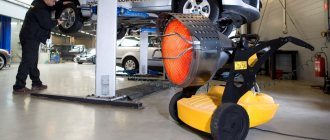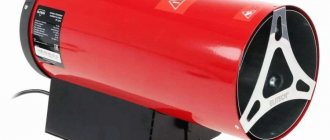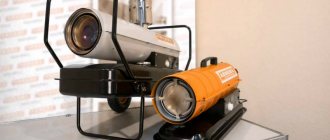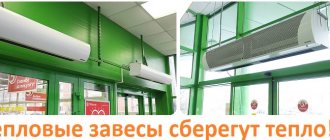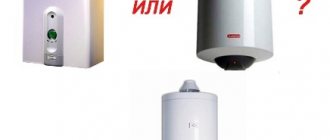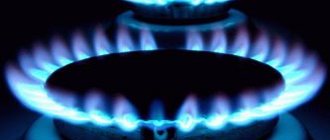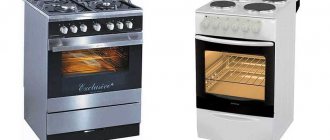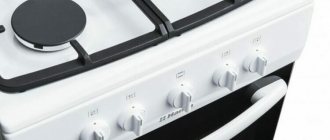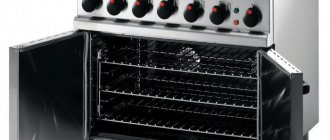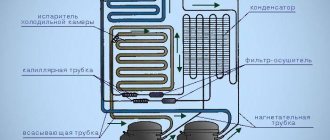Heat guns are high-power heating devices that are used to heat indoor air or create comfortable heat flows outdoors (for various purposes).
Heat guns are divided according to the type of energy used to heat the air:
- electrical;
- diesel;
- gas;
Diesel and gas are also divided into:
- direct action;
- indirect action.
Direct action heat guns
Direct-acting heat guns are used only in well-ventilated rooms and outdoors, due to the principle of their operation.
And the operating principle is based on the combustion of a flammable substance (in this case, diesel fuel) in a special chamber, which ensures its complete combustion. The efficiency of direct heating heat guns is close to 100 percent, but heating occurs with combustion products containing a high content of carbon dioxide and harmful substances.
The combustible substance is supplied to the combustion chamber from the fuel tank by a pump or using an air compressor, which creates a vacuum in the area of the nozzle with a jet of air, which (the vacuum) is enough to lift diesel fuel from the tank (atomizer principle).
Unlike their gas and electric counterparts, diesel heat guns have a fuel supply system, which complicates the system and makes it more expensive. Diesel fuel can be contaminated with impurities and foreign matter, so the power system requires routine maintenance and filters (if any) need to be replaced.
BISON gun "MASTER" thermal, gas, 10.0 kW, TPG-10000_M2
Diesel heat guns are quite efficient and remain an indispensable means of heating in some situations in which it is impossible (or undesirable) to use other types of heaters.
Transportation of diesel fuel is more convenient and safer than gas cylinders (which need to be stored, refueled, transported somewhere), and connecting an electric heat gun of comparable power and comparable efficiency can be problematic.
A full tank of a diesel heat gun (depending on the power and intensity of operation) is enough for 10-15 hours of continuous operation, and a solid fuel supply (up to 50 liters or more) allows you to fill it once per shift.
Types of heat guns
By type of fuel, heat guns differ in:
- Diesel
- Electrical
- Infrared
- Multi-fuel
- Gas
- Mermen
Also, liquid fuel guns (diesel, multi-fuel) are distinguished into guns:
- direct heating,
- and not direct air heating.
Types of heat guns
Direct and indirect air heating guns
Liquid fuel heat guns differ in the method of heating the air and the design of the combustion chamber.
For guns with indirect heating, the fuel burns in the chamber, heating it, and the combustion products go into the chimney connected to this chamber. The fan moves air along the heated chamber and thereby heats the room. The efficiency of such devices is much lower, but combustion products do not enter the room.
Directly heated guns have an efficiency of 100%, but when heating the air, they also emit combustion products along with it. Such guns cannot be used in places where there are people without good ventilation in the room. The conditions for using such guns are indicated in the device passport.
Heat guns for direct and indirect air heating
Each type of gun, differing in the type of fuel, has its own specifics of operation, we will consider each type separately, and then choose for ourselves what we need.
I recommend: 7 tips for choosing a ceiling “bus” curtain rod
Diesel heat guns
Diesel units are used at large construction and industrial sites, in particular for heating the foundation during its installation in the cold season.
The operating principle of diesel guns is as follows. Fuel is supplied by a pump from the fuel tank to the burner nozzle, which sprays fuel, mixing it with air and is ignited by a piezoelectric element.
Diagram of a diesel heat gun
Diesel heat guns that are intended to be used in autonomous mode without supervision must be equipped with a flame control system and a timer.
Electric heat guns
The heating element is a heating element (tubular electric heater) or a metal spiral. Using a heating element is safer, but it takes longer to heat up and cool down than the coils.
The principle of operation is quite simple. Air is supplied through a heated coil or heating element by an electric fan, which upon contact with the coil heats up and goes into the room. Gradually, the air in the room passing through the fan heater warms up to the desired temperature. Such devices are equipped with thermal sensors that turn off the heating element when the user-specified temperature is reached or if the temperature exceeds the maximum permissible value.
Electric heat gun
The main advantage of electric heat guns is that combustion products are not formed, unlike guns running on combustible fuel. Therefore, electric heat guns can be called universal in terms of the possibility of use in residential and non-residential premises.
Electric guns can be turned on at any temperature, unlike liquid fuel guns, which thicken in cold weather. Therefore, they are often used in cold rooms: garages, warehouses, etc.
They provide continuous heating and do not require refueling, as long as the electricity is not turned off, since such guns consume an average of 5 kW (from 1.5 kW to 40 and above).
Infrared heat guns
The difference from other heat guns is the absence of a fan. IR radiation from the device heats the surrounding objects, floors, walls, ceilings, at which the gun is aimed, and the objects heat the air in the room. The air heats up much less and more slowly with this heating method, but a person exposed to infrared radiation becomes warm.
Fireplaces or even fires work on the same principle, which is what a fireplace actually is (a controlled fire inside a room), from which heating occurs according to the same principle.
IR heat guns can be powered by various types of fuel, often diesel. In the combustion chamber, fuel burns and IR radiation spreads through the deflector.
Working principle of IR heat gun
Such guns are used when there is no need to warm up the air in everything, incl. in a large room, or in the open air, pointing the gun at a heated object (person). They are also applicable in repair and finishing work for drying surfaces (although forced drying is often unacceptable, a little bit is possible, or is used in cold and/or damp rooms).
I recommend: Do-it-yourself smart house in the country at minimal cost
Multi-fuel heat guns
Multi-fuel heat guns can operate on different types of fuel:
- diesel,
- kerosene,
- used motor oil.
They work on the same principle as diesel guns, but are more versatile in terms of the choice of liquid fuel. They are also produced with direct heating and with fuel combustion in a chamber with gas exhaust (not direct heating).
They are popular for heating car repair shops and garages because they can operate on used motor oil, recycling it.
Multi-fuel heat gun
Gas heat guns
They run on gas from a cylinder or are connected to the gas network. Gas is supplied to the burner and ignited by piezo ignition. The fan forces air into the combustion chamber, and hot, heated air comes out outside. They have high power and low cost of the device itself. The presence of a fan implies the need to connect the device to the network, but it does not consume much, about 200 W.
Gas heat gun, operating principle
Among the disadvantages, one can note the danger of gas guns and the burning out of indoor air and the formation of carbon dioxide accumulations. Such guns should be used in rooms with good ventilation.
Most often, such guns are used in semi-open spaces, as well as on construction sites and large warehouses, hangars, etc.
They are used when installing PVC stretch ceilings, since they provide fast and sufficient heating of the canvas in a short time, preventing large amounts of oxygen being burned in the room.
There are many models of portable gas guns (heaters), this issue is discussed in more detail → in this article.
Water heat guns
In essence, it is a heater or fan heater - it is a heat exchanger with hot water or other liquid that is connected to the heating system. Simply put, it is a battery with a fan. The unit is mounted on the ceiling or wall and allows you to warm up the air in the room much faster due to its distribution by a fan. It is used in residential premises with central heating, that is, in essence, you need to heat the water first.
Water heat gun
Diesel heat guns for indirect heating
Diesel heat guns of indirect heating allow the use of these heaters in rooms with people and animals, since the toxic exhaust is discharged separately. An additional heating circuit allows you to separate the flow of clean heated air and hot exhaust gases.
The exhaust pipe is located at the top of the heat gun and allows you to connect a fire-resistant hose to discharge combustion products to the street or into the chimney.
Clean air is pumped by a fan through the heating chamber, which is heated from the outside by a flame of combusted diesel fuel. The efficiency of indirectly heated diesel heat guns is naturally lower than that of direct heated diesel heat guns, but remains quite high.
For the operation of power systems, automatic ignition, fans, and protection systems, mains (or any other) electrical voltage is required.
Electrical energy consumption is mainly required to operate an electric fan (usually of low power 50-200 Watts),
piezo ignition or spark plugs.
If mains electricity is unavailable, diesel heat guns can be powered from a generator or battery with an inverter (a device that converts the battery's 12 Volt DC into 220 Volt AC).
An automated control system allows diesel (and other) heat guns to operate without human intervention, that is, a built-in thermostat that controls the ambient temperature issues a command to turn off or ignite the heating equipment.
To avoid emergency situations, heating devices are equipped with a protection system when the fan stops, which reacts to an increase in temperature in the combustion chamber and shuts off the fuel supply.
In more complex models, rollover sensors, oxygen control in the air, flame attenuation, etc. may be installed.
Thermal gun BISON "MASTER" COMPACT ZTP-M1-5000
Gas heat guns
Gas heat guns are simpler than diesel ones due to the lack of fuel supply and filtration systems, so their price is much lower.
Combustible gas is supplied under pressure from a gas cylinder or line, which is why some models of gas heat guns are supplied with gas reducers.
When gas burns, not a lot of harmful substances are released, so gas heat guns of even high power (70 kW or more) are found in a direct version, that is, without exhaust removal (but provision of air access and ventilation are stipulated).
When operating gas heat guns, do not forget that at low temperatures, the evaporation of gas in the cylinders slows down greatly and the pressure may not be enough to start the automatic heating device.
The minimum operating gas pressure is within 0.5 bar.
The automation system monitors the temperature in the burner area and, when the flame dies out, tries to ignite it again (up to three times), and if the flame does not ignite, it shuts off the gas supply.
Gas heat guns are quite efficient heating devices (up to 100 kW and above), and the ability to use 100 percent efficiency makes these units, in some conditions, the best choice.
Gas supply diagram in a gas heat gun
|
After connecting the gas cylinder, the gas enters the gas inlet pipe (1), then into the flame extinguishing chamber (2), the solenoid valve (3), into the gas supply regulator valve (4), into the gas injector (5), then ignition (ignition) occurs from the spark plug.
The thermocouple (7) heats up and facilitates the passage of gas into the flame retardant chamber (2). The thermostat (8) starts the electrical circuit and allows gas to pass through the solenoid valve. Also, the thermostat (8) is responsible for blocking the gas supply (overheating protection).
Electric heat guns
An example of an electric heat gun is a hair dryer, but it is not intended for long-term use.
If it is possible to connect to the electrical network with sufficient power, electric guns will be preferable to their diesel and gas counterparts.
To connect electric heat guns up to 5 kW, a single-phase 220 Volt network is sufficient; when connecting more powerful electrical appliances, a three-phase 380 Volt network is used.
Wires made of alloys with high resistance and different cross-sectional geometries are used as heating elements.
A heating element is a tubular electric heater made in a closed form; a nichrome wire is placed inside the tube, where high-temperature dielectrics are used as an insulator. When opened, it is a wire (nichrome or fechrome) twisted into a spiral, located on ceramic insulators.
Electric heat guns are easy to use, easy to manufacture, easy to adjust, inexpensive, and quite safe.
ZUBR "EXPERT" "Square" thermal electric gun ZTPE-24000-F_M2
Negative factors include the high cost of electricity and the incompatibility of electrical appliances with moisture, dampness and water, in any form.
Electric heat guns are produced in a fireproof design, and the use of heating elements makes them even safer.
With proper connection, operation and use of residual current devices (RCDs), electric heating devices can be considered the simplest and most comfortable to use.
Operating rules
Heat guns of any design (electric, gas, diesel) are not allowed to be covered, as this leads to disruption of air circulation and overheating.
Heat guns cannot be used in cramped conditions, that is, direct the air flow towards an obstacle, which also leads to disruption of air circulation.
Ventilation and access to fresh air are a prerequisite for the operation of powerful heating devices, since heat guns burn oxygen.
When using heat guns in production or construction, it is necessary to take into account that heavy dust levels lead to failure or fire hazard.
Before putting it into operation for the first time, read the manufacturer's instructions and follow its recommendations.
Design of heat guns
The unit is a cylindrical base, which is fixed on an axis with wheels and a stand. The angle of inclination of the pipe is set using a regulator, which makes it possible to direct the warm flow to the desired zone.
The body is made of high-quality metal and is equipped with grilles through which air is drawn in from the room. The heating element located inside brings the air masses to the set temperature, and the fan system pushes them out. Thus, air circulates and is transformed through the cylindrical part of the heat gun.
